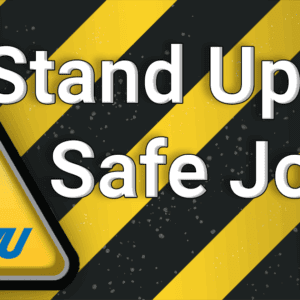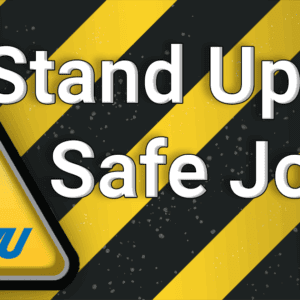October 31, 2009
Garment Worker Expanded Union Ideals Beyond the Workplace
Every time people take a stand to improve the lot of others, “they send forth a tiny ripple of hope,” Robert F. Kennedy once observed. Chicago garment worker Sidney Hillman spent a lifetime sending forth ripples that made big waves — and helped turn the tide of history for American workers.
Along the way, he helped “invent trade unionism as we know it today,” an AFL-CIO tribute notes, by encouraging organized labor to focus its energies on changing the politics and policies that affect all working people.
Hillman was born in 1887 in Lithuania, part of the greater Russian federation, and came of age during the revolutionary turmoil then sweeping Eastern Europe. He quit school at age 15, and joined the General Jewish Labor Union, which sought to unite workers in a political movement against the repressive Czarist regime.
The young activist was arrested at least twice and spent several months in jail for taking part in illegal political activities. After a 1905 uprising against Czar Nicholas II failed, he fled the country. He arrived, penniless, in Chicago in 1907. 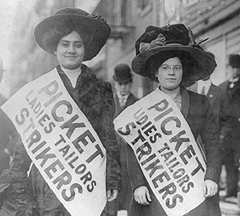
Hillman found work as a fabric cutter in a Hart Schaffner & Marx garment factory, where as an apprentice he worked long hours under brutal conditions. In 1910, when a dozen women walked off the job demanding an end to wage reductions, shorter hours, and union recognition, he walked out, too. What began as a spontaneous job action turned into a citywide strike by 45,000 garment workers, and Hillman earned a reputation as a rank-and-file leader.
After a bitter, four-month strike, Hillman was instrumental in convincing the employer to accept most worker demands, including recognition of newly formed Local 39 of the United Garment Workers (UGW), and an agreement to settle some future disputes by arbitration. Local members made him their business agent, and he helped the union make gains with other Chicago employers.
Inspired in large part by the Chicago local’s success, garment workers in other cities began to concentrate their efforts to organize under the mantle of the UGW. In 1914, however, a group of locals representing two-thirds of the UGW membership at the union’s convention broke away to form the Amalgamated Clothing Workers of America (ACWA), with Hillman as president. Many locals had been upset by the national UGW’s efforts to disenfranchise many of the larger, more militant urban locals at the convention, and many remained displeased that the UGW had tried to pressure the Chicago local and others to accept inadequate settlements during job actions.
By 1920, ACWA represented 177,000 workers and had won contracts with 85 percent of the nation’s garment manufacturers. ACWA members enjoyed far better wages and working conditions than non-union garment workers, as well as a 44-hour work week — a full decade before the nation’s first wage-and-hour laws were to take effect. 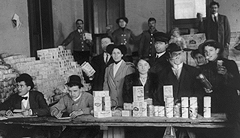
Hillman would remain ACWA’s president for 32 years, and would be instrumental in helping to shape the modern labor movement and many of the laws and policies affecting working families to this day.
‘Constructive Cooperation’
Hillman worked to keep garment-industry employers from undercutting each others’ pay schemes by establishing industry-wide wage and hour standards, and he favored arbitration over strikes to resolve contract disputes.
The ACWA president also believed that unions should work with management to help unionized companies and industries become more productive, a doctrine he referred to as “constructive cooperation.“ As he explained, in 1938:
“Certainly, I believe in collaborating with the employers! That is what unions are for…. “For then, we will have a claim to higher wages, shorter hours, and greater participation in the benefits of running a smooth industrial machine.”
Hillman’s philosophy did not sit well with many union activists, but others saw positive effects and deemed his “new unionism” an effective alternative to relying solely on strikes and job actions to achieve worker goals. For good or ill, the grievance-arbitration system that Hillman and garment manufacturers first instituted in Chicago in 1914 remains a widely used tool in labor relations today.
Hillman was among the first labor leaders to expand union activities beyond the workplace. The ACWA leveraged its might to create unemployment insurance and low-cost housing for its members, and it established banks that kept workers interests in mind — especially when they loaned money to employers.
The New Deal
The ACWA continued to grow throughout the 1920s, but after the Great Depression began in late 1929, millions of union and nonunion jobs disappeared, and garment worker ranks shrank accordingly. Hillman was a strong supporter of Franklin D. Roosevelt’s presidential campaign in 1932, and he pressed FDR’s New Deal administration to strengthen workers’ rights to organize under the National Recovery Act. As a result, union membership rebounded as the economy stabilized and grew.
FDR named Hillman to a number of important advisory posts, which the former garment cutter used to help shape and pass the National Labor Relations Act (1935), which protects workers’ rights to strike and bargain collectively, and the Fair Labor Standards Act (1938), which outlawed child labor, created the minimum wage, and mandated overtime pay. In the coming decades, the two landmark laws helped unions grow, and lifted millions of workers out of poverty, creating the strongest economic engine in world history.
The CIO
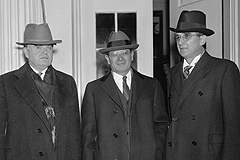 In the 1930s, Hillman was also a leading figure among unionists in supporting “industrial unionism,” the movement to organize all workers in an industry — regardless of skill or trade – into the same union, thus giving workers more leverage in bargaining and in strike situations.
In the 1930s, Hillman was also a leading figure among unionists in supporting “industrial unionism,” the movement to organize all workers in an industry — regardless of skill or trade – into the same union, thus giving workers more leverage in bargaining and in strike situations.
With Hillman’s leadership, the ACWA, the United Mine Workers, and several other large unions broke away from the American Federation of Labor, which represented mostly skilled workers and did not support the organizing effort, to form the Congress of Industrial Organizations, in 1937. (The AFL and the CIO reunited in 1955.)
As the CIO’s first vice president beginning in 1937, Hillman spearheaded successful organizing drives that led to the formation of the Retail, Wholesale and Department Store Union and the Textile Workers Union. Other CIO-led campaigns succeeded in organizing many thousands of workers in steel, automotive, and other industries, helping to build the United Steelworkers and United Auto Workers unions into effective national labor organizations.
Politics
 On the eve of World War II, Hillman pressed for U.S. aid to England and France against threats from Nazi Germany, and he subsequently served on several panels that helped organized labor contribute to an unprecedented war-production effort. The Roosevelt administration’s war-era labor policies, which Hillman helped direct, “spurred union growth and laid the foundation for postwar prosperity and union influence,” an AFL-CIO tribute to the CIO leader notes.
On the eve of World War II, Hillman pressed for U.S. aid to England and France against threats from Nazi Germany, and he subsequently served on several panels that helped organized labor contribute to an unprecedented war-production effort. The Roosevelt administration’s war-era labor policies, which Hillman helped direct, “spurred union growth and laid the foundation for postwar prosperity and union influence,” an AFL-CIO tribute to the CIO leader notes.
As a final achievement, Hillman marshaled the CIO’s energies and resources to create a powerful political organization that helped FDR win re-election in 1944 amid a conservative backlash.
In 1946, at what many would say was the height of his prominence and influence, Sidney Hillman died of a heart attack at his home on the south shore of Long Island. He was 59.
The Sidney Hillman Foundation, established by ACWA in 1946, awards Hillman Prizes (annually) and “Sidneys” (monthly) for journalism that fosters social and economic justice.

